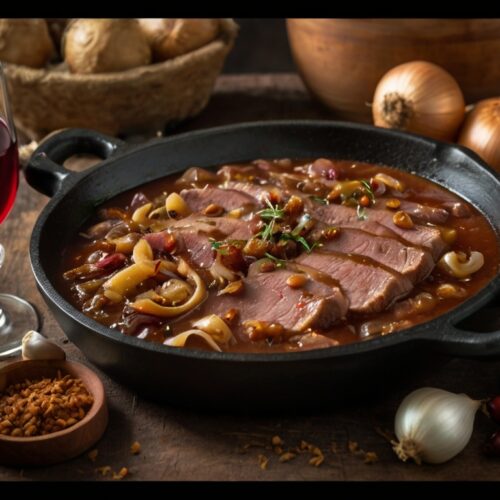In ancient Rome, the dining table wasn’t just a place to eat; it was a stage for the wealthy to flaunt their status through elaborate feasts and finely crafted dishes.
Vitellina fricta, or fried veal, is a prime example of this culinary display, hailing from the famed Roman cookbook De Re Coquinaria attributed to Apicius.
This dish showcases the rich flavors, exotic ingredients, and sophistication of the Roman aristocratic palate. With tender veal seared in olive oil and dressed in a sauce layered with sweet, tangy, and savory notes, vitellina fricta embodies the Roman ideal of indulgent, artfully balanced cuisine.
Origins: Apicius and Roman Culinary Artistry
The recipe for vitellina fricta appears in De Re Coquinaria, a culinary treasure trove attributed to the gourmet Marcus Gavius Apicius, though it was likely compiled centuries later, around the 4th or 5th century AD.
The collection offers a rare glimpse into the dining habits of the elite in Rome, where aristocratic feasts featured ingredients sourced from across the empire, such as spices from Asia, North African herbs, and exotic sauces.
Veal was prized for its tenderness and subtly rich flavor, making it a luxurious meat option often reserved for the upper echelons of society.
To elevate the veal, this recipe called for a complex sauce that included sweet raisins, honey, tangy vinegar, and reduced grape must (defritum), a rich ingredient made by boiling grape juice into a concentrated syrup. Each element, from the quality of the veal to the imported spices, contributed to making vitellina fricta a symbol of wealth and culinary sophistication.
Substituting Grape Must (Defritum)
Defritum, a boiled-down grape must, was a common ingredient in Roman cooking, imparting a sweet and tangy flavor to dishes.
It’s not as widely available today, but you can create a similar flavor profile by using a mixture of grape juice and a touch of balsamic vinegar, reduced until it thickens to a syrupy consistency. This substitute will give you the rich, fruity sweetness of defritum with just a hint of acidity.
Roman Aristocratic Feasts
In ancient Rome, feasts held by the aristocracy were much more than meals; they were displays of wealth, status, and cultural refinement.
Known as convivia, these gatherings featured an array of luxurious foods, fine wines, and elaborate dishes meant to impress guests and showcase the host’s access to rare ingredients.
Aristocrats would source spices from as far as India, fish sauces from the coasts, and special fruits from the Mediterranean, all through Rome’s vast trade networks.
These banquets were carefully curated experiences, designed to elevate not just taste but social standing. Often hosted in lavish triclinia (dining rooms with couches for reclining), guests dined while lounging, a custom reserved for the elite.
Dishes like vitellina fricta were ideal for such feasts, as they combined high-quality meat with rare spices, layered flavors, and beautiful presentation. A successful feast would leave guests in awe of both the culinary expertise on display and the wealth it implied, reinforcing the host’s social power.
Recipe for Vitellina Fricta:

Vitellina Fricta: Sweet & Sour Fried Veal
Ingredients
- Veal sliced into serving pieces
- 2 tbsp olive oil for frying
- 2 tbsp dried raisins or sultanas
- 1 tbsp honey
- 1 tbsp vinegar
- ½ cup white wine
- 2 –3 tbsp defritum or substitute: ½ cup grape juice mixed with 1 tsp balsamic vinegar, reduced
- 1 tsp liquamen or salt if unavailable
- ¼ tsp each: pepper celery seeds, lovage (or substitute with celery salt), cumin, oregano, dried onion
Instructions
Fry the Veal
- Heat olive oil in a pan over medium heat. Sear the veal pieces until browned on all sides, about 3–4 minutes per side. Remove and set aside.
Prepare the Sauce
- In the same pan, add raisins, white wine, vinegar, honey, olive oil, defritum (or reduced grape juice mixture), liquamen (or salt), and all spices. Stir well to combine.
Reduce the Sauce
- Bring the sauce to a gentle boil, then reduce heat to a simmer. Let it cook for about 10–15 minutes, or until it thickens to a syrupy consistency.
Combine and Simmer
- Return the veal to the pan, coating it with the sauce. Cover and cook on low heat for 5–10 minutes, allowing the flavors to meld and the veal to become tender.
Serve
- Remove from heat and serve the veal drizzled with the sauce. Enjoy this ancient Roman delicacy as it would have been savored by the aristocrats of old.
Notes
- Grape Must Substitute: For the best flavor, use reduced grape juice with a touch of balsamic vinegar to replicate the tangy, sweet defritum.
- Adjust Spices to Taste: Feel free to adjust the amounts of cumin, pepper, and oregano for a flavor profile that best suits your palate.
- Simmer for Flavor: Allow the sauce to reduce thoroughly to enhance its richness and ensure it clings to the veal pieces for a satisfying finish.